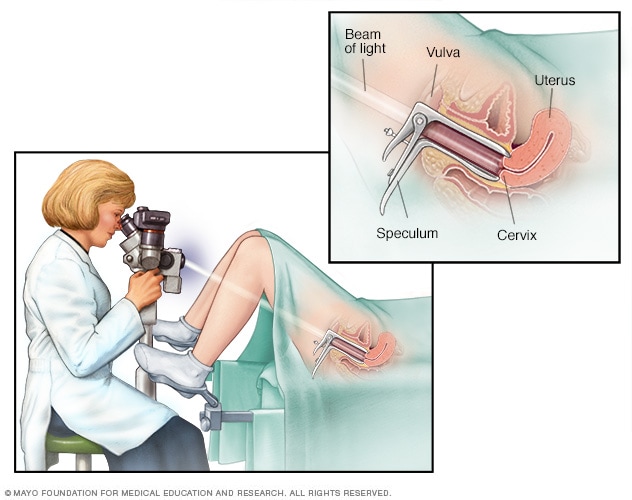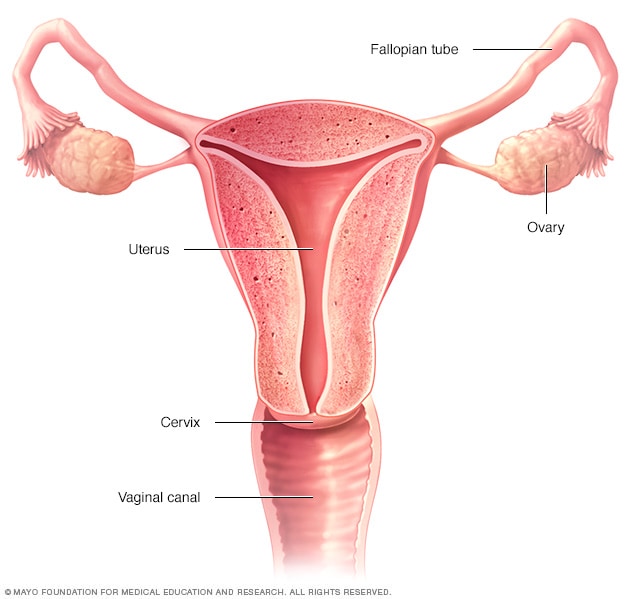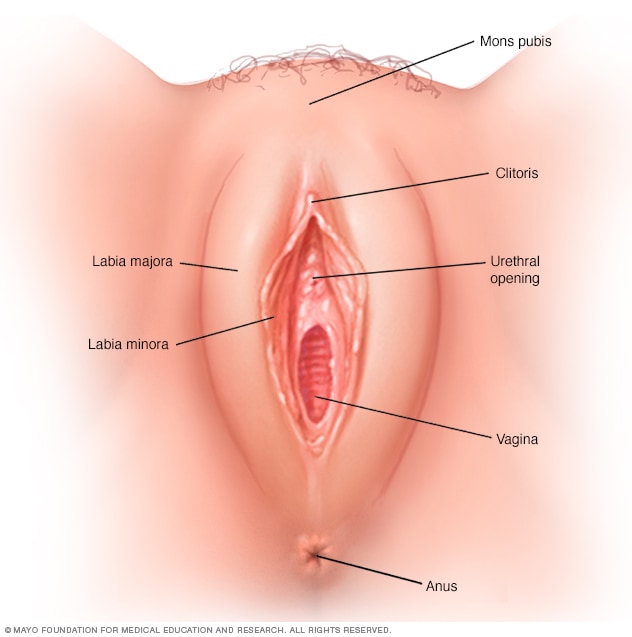Overview
Colposcopy

Colposcopy
Colposcopy is an exam that looks closely at the cervix. It uses a special magnifying instrument to do this. The instrument also may be used to look at the vagina and vulva.
Colposcopy is an exam that looks closely at the cervix. It uses a special magnifying instrument to do this. The instrument also may be used to look at the vagina and vulva.
Colposcopy, which is pronounced kol-POS-kuh-pee, looks for signs of disease. A colposcopy may be recommended if a Pap test result shows something concerning. If your healthcare team finds a suspicious area of cells during your colposcopy procedure, a sample of tissue can be collected for testing.
It's common to feel anxious before a colposcopy exam. Knowing what to expect during your colposcopy may help you feel more comfortable.
Products & Services
Why it's done
Female reproductive system

Female reproductive system
The ovaries, fallopian tubes, uterus, cervix and vagina (vaginal canal) make up the female reproductive system.
Vulva

Vulva
The vulva is the outer part of the female genitalia, including the labia majora, labia minora and clitoris.
A healthcare professional may recommend colposcopy if a Pap test or pelvic exam finds something concerning.
Colposcopy can help diagnose:
- Genital warts.
- Inflammation of the cervix, called cervicitis.
- Noncancerous growths on the cervix, such as polyps.
- Precancerous changes in the tissue of the cervix.
- Precancerous changes in the tissue of the vagina.
- Precancerous changes of the vulva.
- Cancer of the cervix, called cervical cancer.
- Cancer of the vagina, called vaginal cancer.
- Cancer of the vulva, called vulvar cancer.
Risks
Colposcopy is a safe procedure that has very few risks. Rarely, complications from biopsies taken during colposcopy can happen. A biopsy is a procedure to remove a sample of tissue for testing in a lab. Biopsy complications may include:
- Heavy bleeding.
- Infection.
- Pelvic pain.
How you prepare
To prepare for your colposcopy, your healthcare team may recommend that you:
- Avoid scheduling your colposcopy during your period.
- Don't have vaginal intercourse the day or two before your colposcopy.
- Don't use tampons the day or two before your colposcopy.
- Don't use vaginal medicines for the two days before your colposcopy.
- Take a pain reliever, such as ibuprofen (Advil, Motrin IB, others) or acetaminophen (Tylenol, others), before going to your colposcopy appointment.
Coping with feeling anxious before colposcopy
It is common to feel anxious before a colposcopy appointment. Being anxious can make you feel generally uncomfortable. You may find it hard to concentrate. You also may have difficulty sleeping.
People who are very anxious about colposcopy may have more pain during the procedure than people who find ways to cope with and manage their feelings.
Things that can help with feeling anxious about colposcopy include:
- Asking your healthcare professional for brochures or pamphlets about colposcopy and what you can expect.
- Writing down any questions or concerns you have about the procedure. Ask your healthcare professional to review them with you before your colposcopy begins.
- Finding activities that help you relax, such as exercise, meditation, and being with friends and family.
- Listening to music quietly during the exam.
What you can expect
During the colposcopy
Colposcopy is usually done in a healthcare professional's office. The procedure typically takes 10 to 20 minutes. You'll lie on your back on a table with your feet in supports, just as during a pelvic exam or Pap test.
A metal or plastic speculum is placed in your vagina. The speculum holds open the walls of your vagina so that your healthcare professional can see your cervix.
The special magnifying instrument, called a colposcope, is placed a few inches away from your vulva. Your healthcare professional shines a bright light into your vagina and looks through the lens of the colposcope, as if using binoculars.
Your cervix and vagina are swabbed with cotton to clear away any mucus. A solution of vinegar or another type of solution may be applied to the area. This may cause a burning or tingling sensation. The solution helps highlight any areas of suspicious cells.
During the biopsy
If your healthcare professional finds a suspicious area, a small sample of tissue may be taken for lab testing. To collect the sample, a sharp biopsy instrument is used to remove a small piece of tissue. If there are multiple suspicious areas, your healthcare professional may take multiple biopsy samples.
A chemical solution may be applied to the biopsy area to limit bleeding.
After the colposcopy
If your healthcare professional didn't do a biopsy during your colposcopy, you won't have any restrictions on your activity once your exam is complete. You may experience some spotting or very light bleeding from your vagina in the next day or two.
If you had a biopsy sample taken during your colposcopy, you may experience:
- Vaginal or vulvar pain that lasts one or two days.
- Light bleeding from your vagina that lasts a few days.
- A dark discharge from your vagina.
Use a pad to catch any blood or discharge. Avoid tampons, douching and vaginal intercourse for a week after your biopsy, or for as long as you're instructed.
When to call your healthcare team
Contact your healthcare team if you have any lasting symptoms that worry you.
Symptoms that may indicate complications include:
- Bleeding that is heavier than what you usually have during your period.
- Chills.
- Fever.
- Severe stomach pain.
Results
Before you leave your colposcopy appointment, ask your healthcare professional when you can expect the results. Also ask for a phone number you may call if you don't hear back within a specified time.
The results of your colposcopy will determine whether you'll need any further testing and treatment.